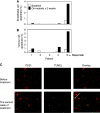Phase II trial of imatinib mesylate in patients with metastatic melanoma
- PMID: 18728664
- PMCID: PMC2528157
- DOI: 10.1038/sj.bjc.6604482
Phase II trial of imatinib mesylate in patients with metastatic melanoma
Abstract
Metastatic melanoma cells express a number of protein tyrosine kinases (PTKs) that are considered to be targets for imatinib. We conducted a phase II trial of imatinib in patients with metastatic melanoma expressing at least one of these PTKs. Twenty-one patients whose tumours expressed at least one PTK (c-kit, platelet-derived growth factor receptors, c-abl, or abl-related gene) were treated with 400 mg of imatinib twice daily. One patient with metastatic acral lentiginous melanoma, containing the highest c-kit expression among all patients, had dramatic improvement on positron emission tomographic scan at 6 weeks and had a partial response lasting 12.8 months. The responder had a substantial increase in tumour and endothelial cell apoptosis at 2 weeks of treatment. Imatinib was fairly well tolerated: no patient required treatment discontinuation because of toxicity. Fatigue and oedema were the only grade 3 or 4 toxicities that occurred in more than 10% of the patients. Imatinib at the studied dose had minimal clinical efficacy as a single-agent therapy for metastatic melanoma. However, based on the characteristics of the responding tumour in our study, clinical activity of imatinib, specifically in patients with melanoma with certain c-kit aberrations, should be examined.
Figures



References
-
- Ashman LK (1999) The biology of stem cell factor and its receptor C-kit. Int J Biochem Cell Biol 31: 1037–1051 - PubMed
-
- Barnhill RL, Xiao M, Graves D, Antoniades HN (1996) Expression of platelet-derived growth factor (PDGF)-A, PDGF-B and the PDGF-α receptor, but not the PDGF-β receptor, in human malignant melanoma in vivo. Br J Dermatol 135: 898–904 - PubMed
-
- Buchdunger E, Zimmermann J, Mett H, Meyer T, Muller M, Druker BJ, Lydon NB (1996) Inhibition of the Abl protein-tyrosine kinase in vitro and in vivo by a 2-phenylaminopyrimidine derivative. Cancer Res 56: 100–104 - PubMed
Publication types
MeSH terms
Substances
Grants and funding
LinkOut - more resources
Full Text Sources
Other Literature Sources
Medical
Miscellaneous

